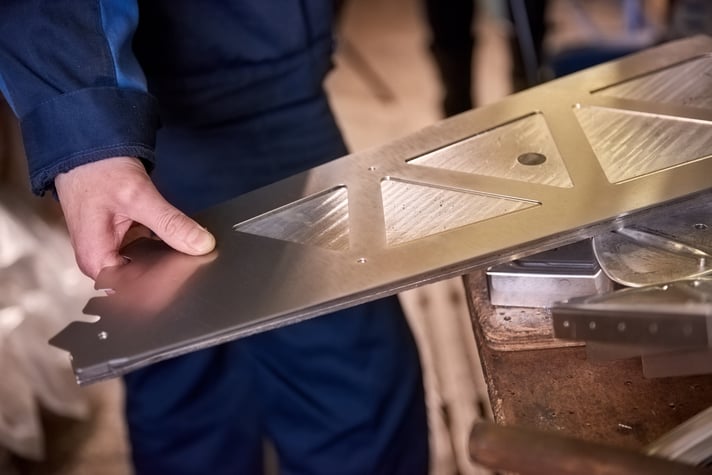
Aluminum is known for being one of the lightest engineering metals that has a higher strength-to-weight ratio than steel. Pure aluminum is also a soft and flexible metal with high electrical/thermal conductivity and corrosion-resistant properties. To provide better strength to aluminum for more demanding applications, it is commonly alloyed with other metals, such as copper, zinc, magnesium, silicon, manganese, and/or lithium.
Aluminum alloy 6063 (AA6063) is a medium strength alloy, commonly used in extrusion applications. Grade 6063 has good mechanical properties and is also heat treatable and weldable. There are a variety of popular applications for this metal, including architectural applications, window frames, doors, roofs, sign frames, shop fittings, and irrigation tubing. The grade specs for AA6063 allow for the following compositional ranges: 0.2-0.6% Si, 0-0.35% Fe, 0.45-0.9% Mg, 0.1% max Cr, 0-0.1% for Cu, Mn, Ti and Zn. Our new MBH-AL6063-20 standard falls well within these ranges with Si=0.46%, Fe=0.156%, Mg=0.481%, Cr=0.0088%, and under 0.1% for Cu, Mn, Ti, and Zn. It is supplied in a 50mm x25mm disk for OES application, or as chips for easy digestion for liquid analysis techniques.
The other four new alloys have all been made specifically doped with measurable concentrations of typical trace/tramp elements. This allows them to be used to verify low-level analysis of these elements. They are also provided as either a disk with 65mm diam (25mm thick) or as chips for easy dissolution. This larger size allows for more sparks per polish, and less re-surfacing for OES techniques. The manufacturing process for these alloys also results in highly homogenous bars, so the composition will be very consistent throughout the sample.
 Aluminum grade 6061 (AA6061) is the most commonly available aluminum alloy on the market. This grade is often used in applications where high strength is required, and the typical applications for AA6061 are general purpose or manufacturing needs including truck and marine components, furniture, pipelines, heavy-duty structures, railroad cars, and high-pressure applications. Our new MBH-AL6061-19 reference material meets the grade criteria elements with Mg=0.896%, Si=0.71%, Cu=0.247%, and Cr=0.254%. The COA also lists certified concentrations for 13 other elements, including Bi, Cd, Pb, and Sb.
Aluminum grade 6061 (AA6061) is the most commonly available aluminum alloy on the market. This grade is often used in applications where high strength is required, and the typical applications for AA6061 are general purpose or manufacturing needs including truck and marine components, furniture, pipelines, heavy-duty structures, railroad cars, and high-pressure applications. Our new MBH-AL6061-19 reference material meets the grade criteria elements with Mg=0.896%, Si=0.71%, Cu=0.247%, and Cr=0.254%. The COA also lists certified concentrations for 13 other elements, including Bi, Cd, Pb, and Sb.
Alloy 356.2 (AA356.2) is another high-strength aluminum alloy commonly used in aircraft applications. AA356.2 can also be used as a substitute for aluminum alloy 6061 if needed. Typically, this grade is used in pump housings, impellers, high-velocity blowers, and structural castings where high strength is required. Our new MBH-AL356.2-19 meets the grade requirements, with Fe=0.22%, Mg=0.39%, Si=6.9%, and Ti=0.185%. The COA for this alloy also lists certified values for an additional 16 elements including Bi, Ca, Cd, Co, Cr, Ga, and Sb.
Aluminum alloy 3104 (AA3104) is the most commonly used alloy for aluminum can bodies, due to its ability to be easily formed, and yet maintain its strength in the finished form. Our new MBH-AL3104-20 standard meets all grade requirements, with Cu=0.197%, Mg=1.10%, Mn=1.07%, and Fe=0.315%. The COA also lists certified concentration values for an additional 15 elements, including Be, Bi, Cd, Pb, Sb, Sr, and Ti.
Finally, alloy 5182 (AA5182) is a lightweight and malleable metal that has been in use for centuries. Common applications for this aluminum alloy include automobile applications (body panels and reinforcement members), aluminum can tops, brackets, and packaging products such as containers. Its composition includes magnesium and manganese as minor elements, ranging from 4-5% Mg and 0.2-0.5% Mn. Our new MBH-AL5182-20 CRM hits the mark with Mg=4.01% and Mn=0.39%. This COA also lists many trace elements, with a total of 19 total certified concentrations, for the alloying elements as well as trace elements such as Be, Bi, Cd, and Sb to name a few.
For more information on any of these elements, or to request a quote


